This is a beautiful collection of Polychromatic Ornament prints by Albert Racinet, all in the Public Domain.
They are from his 1877 book “Polychromatic Ornament. One hundred plates in gold, silver, and colours, comprising upwards of two thousand specimens of the various styles of ancient, oriental, and medieval art, including the Renaissance and the seventeenth and eighteenth centuries.”
Polychrome Ornaments
According to Wikipedia, Polychrome is the “practice of decorating architectural elements, sculpture, etc., in various colours.” The term refers to architectural, pottery, or sculpture styles in multiple colours.
Like Jones’s Grammer of Ornament, Albert Racinet’s book is a collection of colourful plates. They are drawings of ornamental designs from several cultural and artistic periods. The illustrations are drawn from a wide variety of sources of design. These include woodwork, metalwork, architecture, textiles, painting, and pottery.
Rather than trying to theorize about the designs, the purpose of Albert Recinet’s book was to teach by practical examples. In the book, he says, “there is nothing more eloquent than the sight of the masterpieces themselves and no need to provide any analysis“.
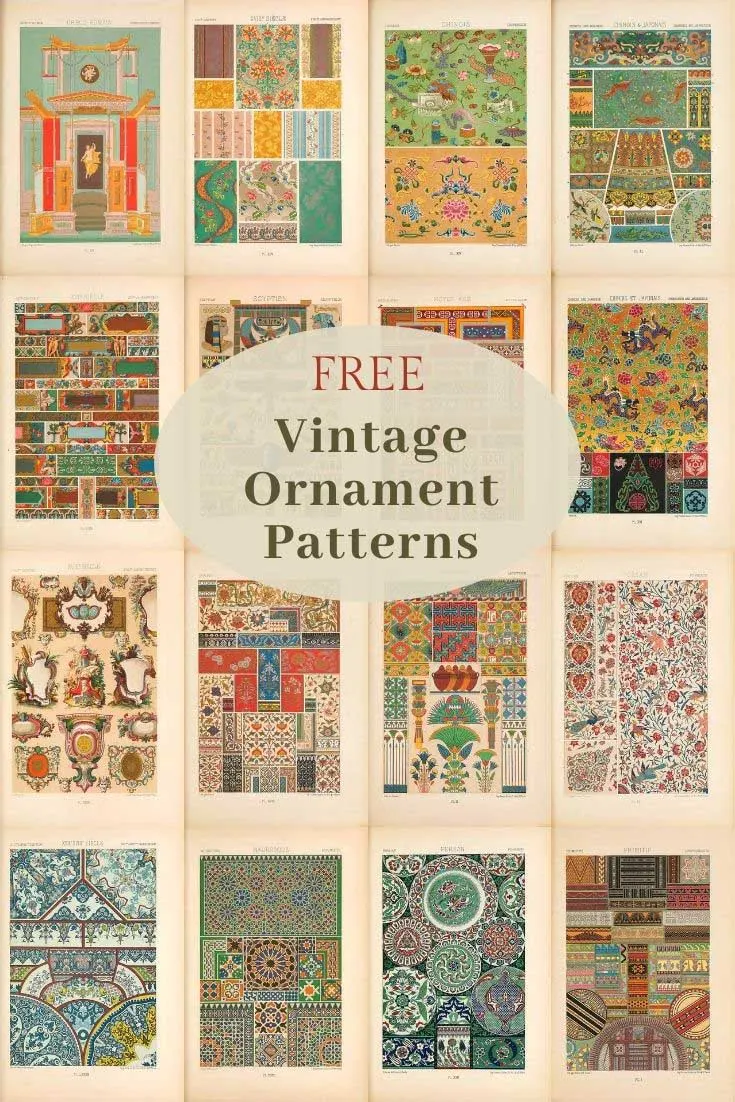
Albert Racinet (1825-1893)
Albert Racinet published two major publications in his lifetime. This book the L’Ornement Polychrome. And another beautifully illustrated book on historical costumes, Le Costume Historique.
He was born in France in 1825 and was a costume historian, illustrator, and painter. He worked as an engraver and artistic director for the publisher Firmin Didot et Cie from 1869 to 1888.
To download the Polychromatic Prints you want from the book, click the illustration title. A higher-resolution image should open in a new window in your browser. If you right-click that image with your mouse, you can save it to your device.
1. Primitive Art
Below is a primitive polychromatic ornament example of woven fabrics, sculptures, and paintings. It is derived from very different sources which connect with civilizations that are in some respects analogous.
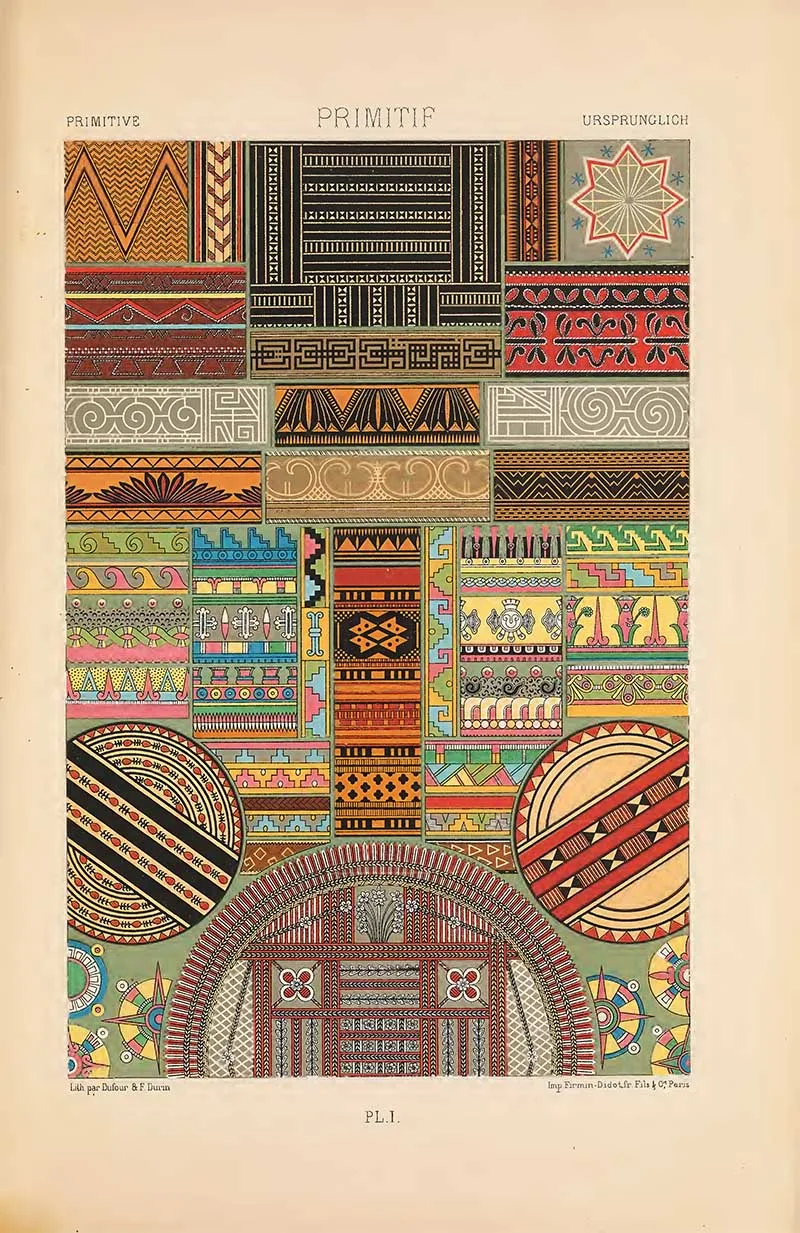
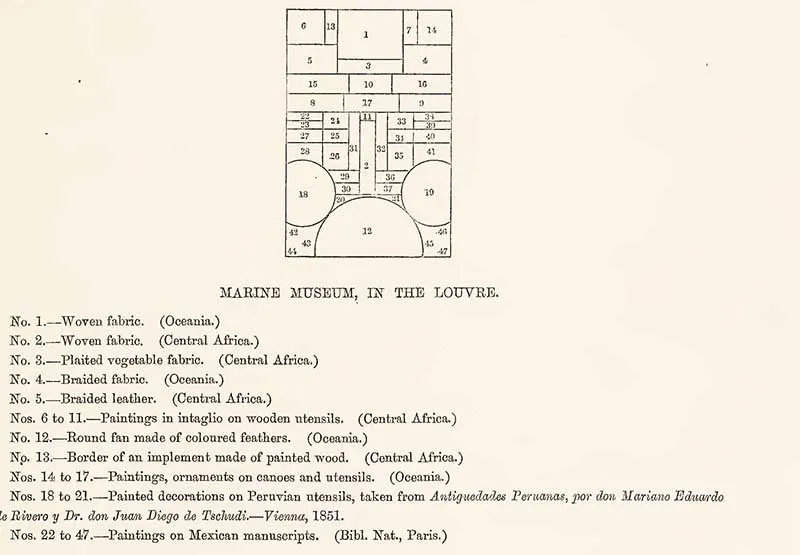
2. Egyptian Ornament
Albert Racinet says of this plate that “the signification of principal objects employed in Egyptian ornament is generally found in the language of hieroglyphics“. For example, the pink sphere with the hawk’s wings represents the rising sun. The water flowers mingled with reeds in the lower part of the plate are types of running water.
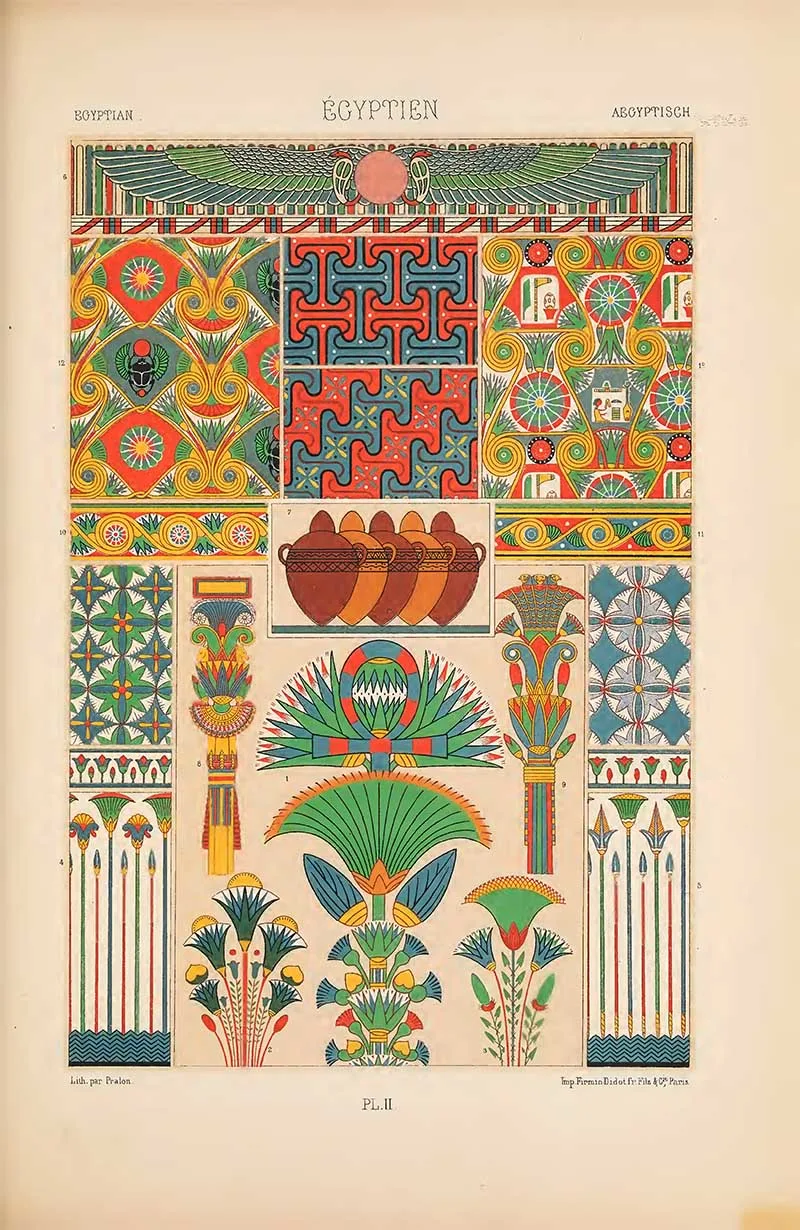
3. Egyptian Jewelry
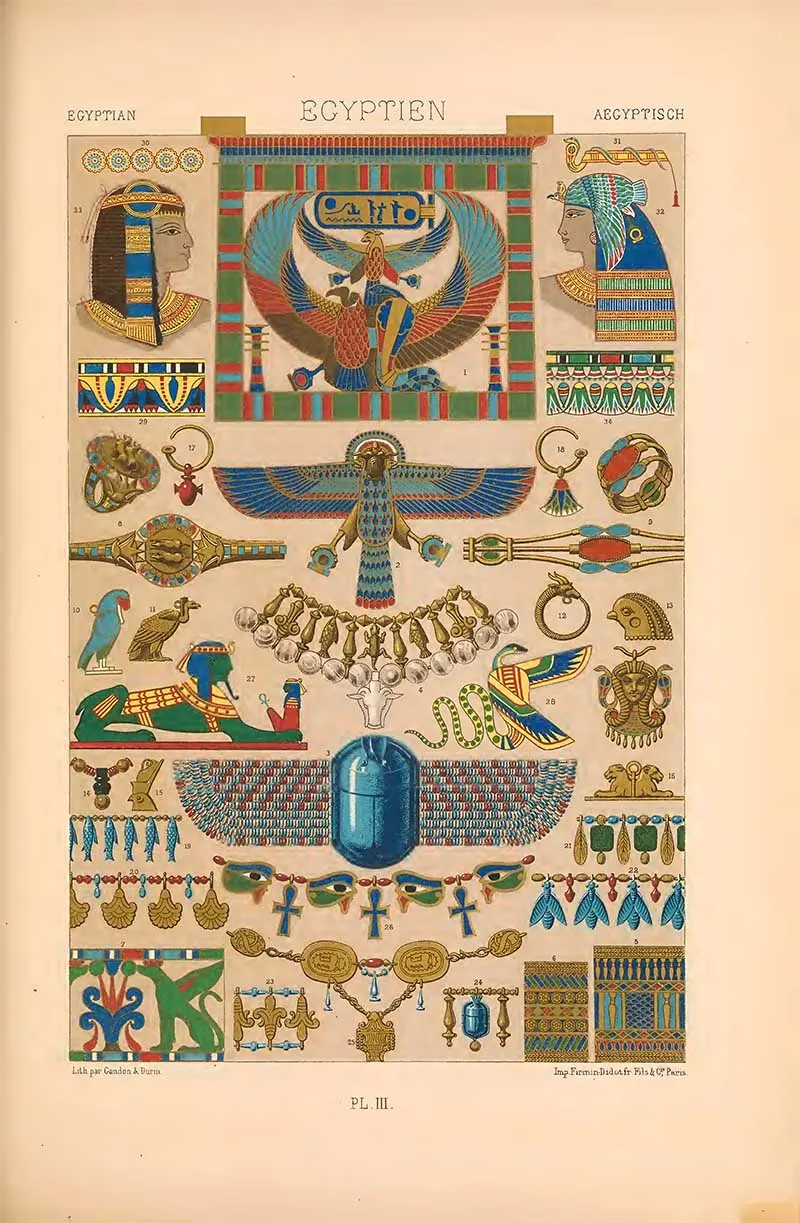
4. Greek Polychromatic Ornaments – Albert Racinet
The accompanying plate contains numerous polychromatic decoration specimens taken from various Greek art periods. They commenced from the date of the monuments in the Parthenon down to that which may be called the Greco-Roman period.
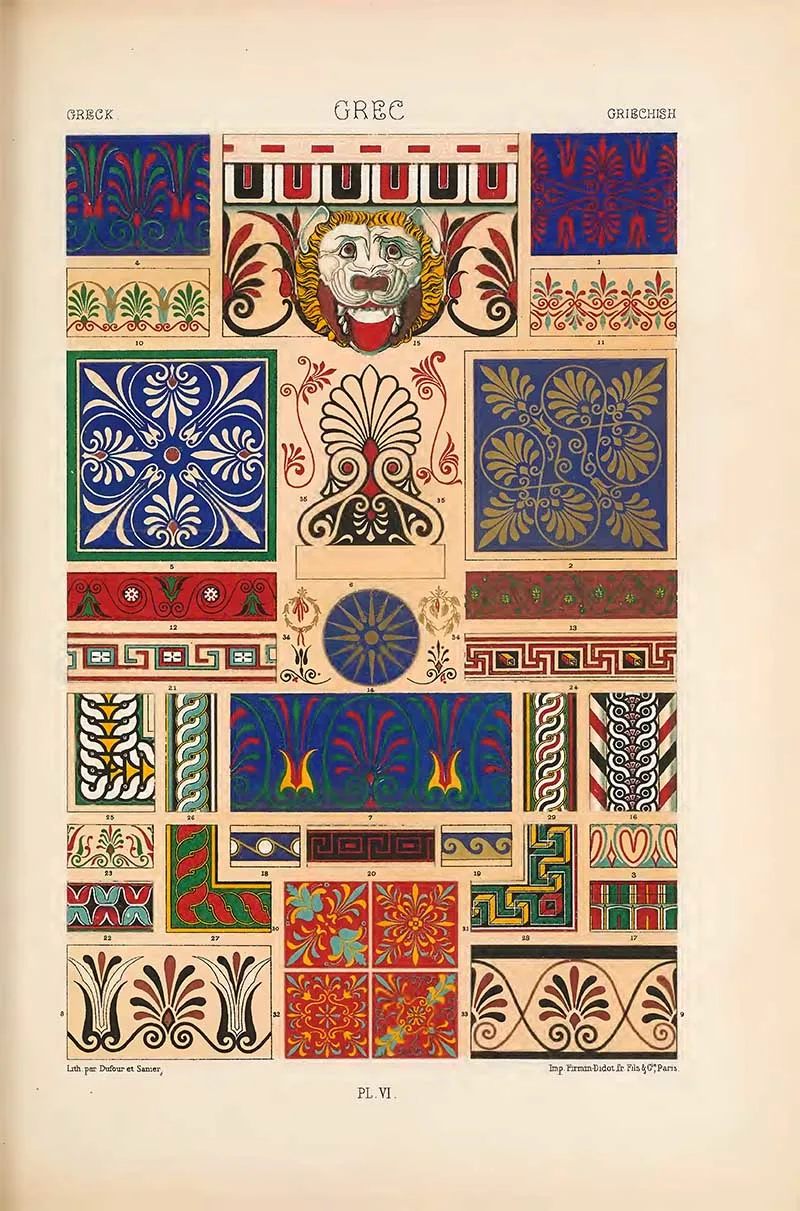
5. Greco – Roman Ornament
The plate is a painted wall from the Casa delle Suonatrici, taken from the great work of Zahn: Les Plus beaux ornaments et les tableaux les plus remarquables de Pompei, d’Herculansum et de Stabiae, 1828-30. It is considered one of the finest of its kind. The two single figures have been added and weren’t in the original.
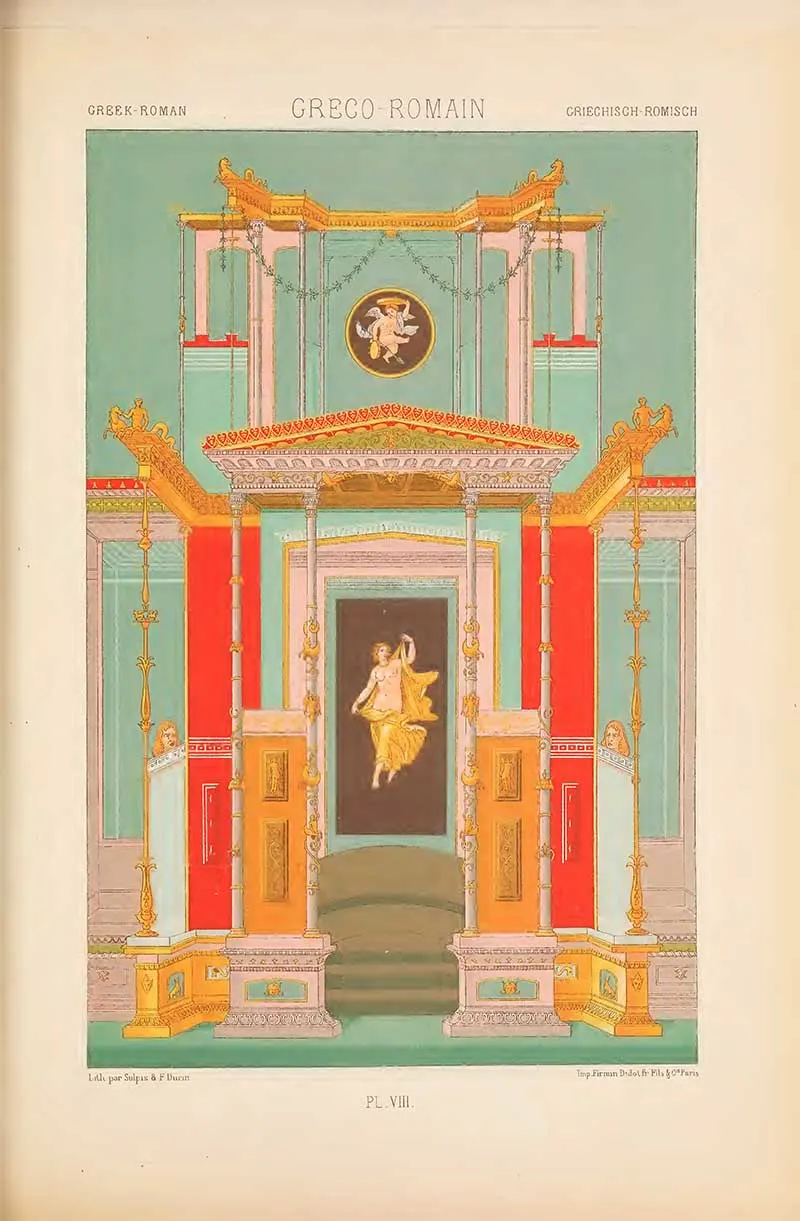
6. Chinese and Japanese Silks
The large yellow design is a Chinese pattern, and the smaller prints are Japanese. They are all patterns found on silk fabrics.
For more Japanese designs check out the Shin Bijutsukai Art collection.
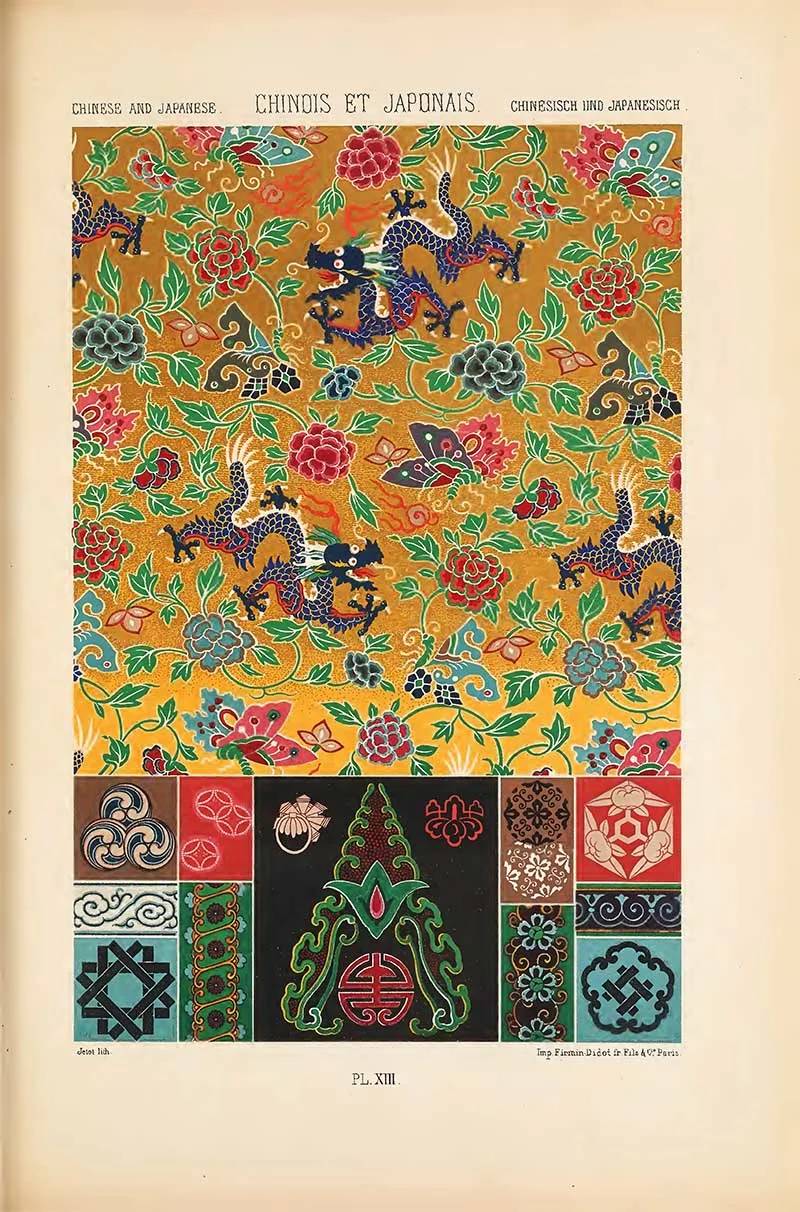
7. Chinese and Japanese Art
Albert Racinet wrote, “It is difficult to understand how such powerful effects can be produced by means so simple, and Europeans can hardly do better than make a careful study of that bold use of intense colours which, directed by Asiatic taste, produces such marvellous results.”
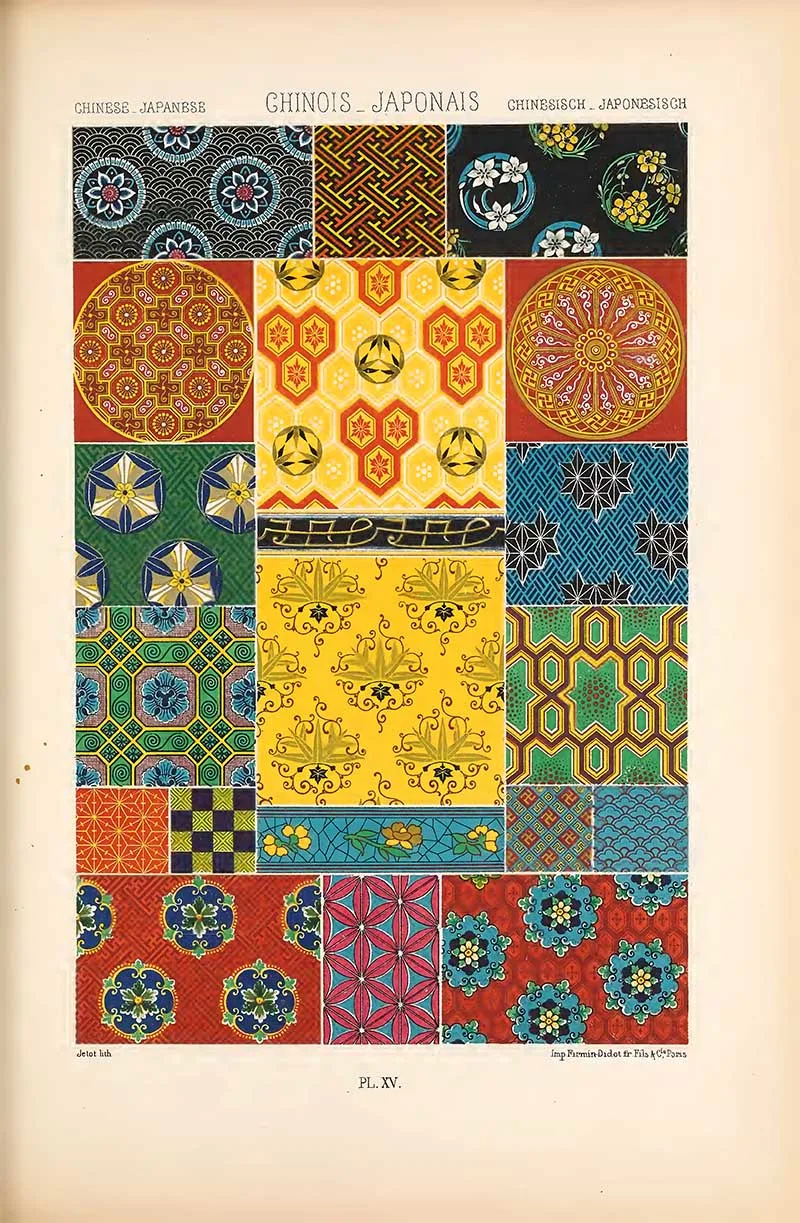
8. Chinese Art L’Ornement Polychrome
Albert Racinet examples of free form Chinese art decorations.
Check the amazing Chinoiserie interior designs in the Brighton Pavilion.
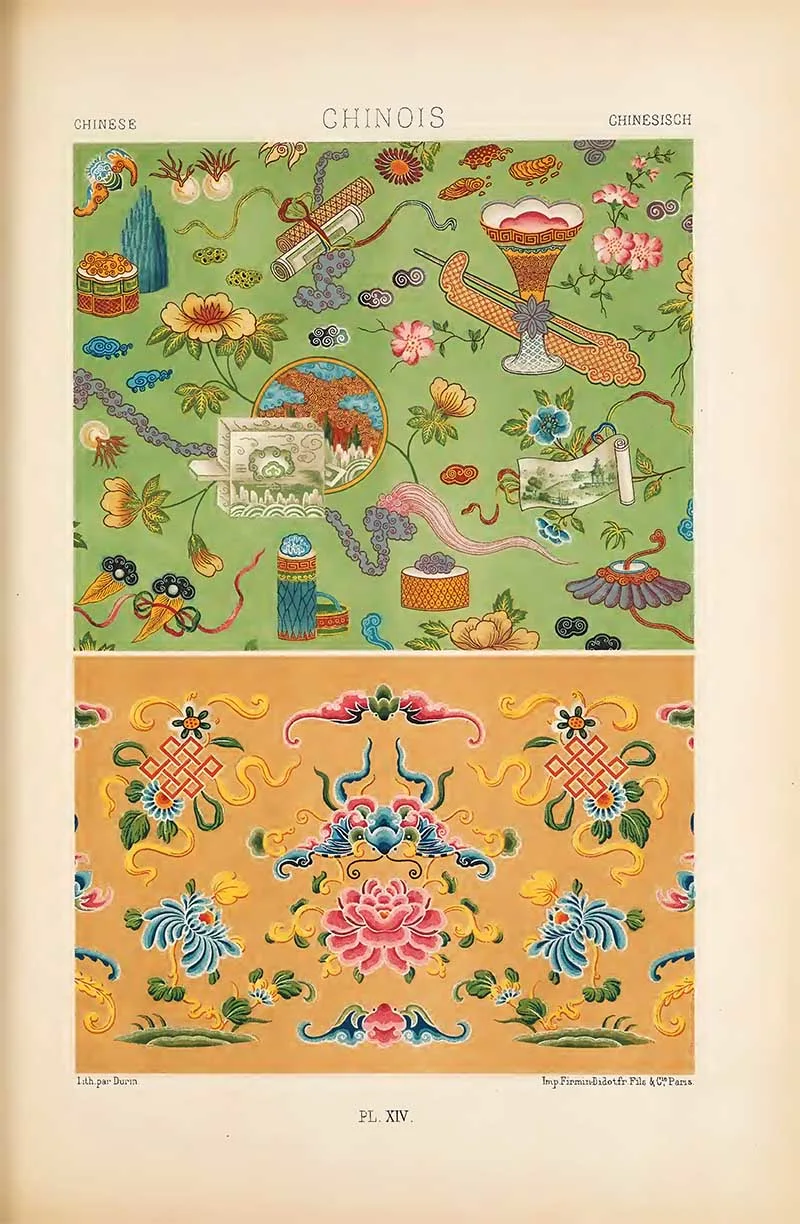
9. Chinese and Japonese Cloisonné Enamel
Cloisonné is an ancient technique for decorating metalwork objects with coloured material held in place or separated by metal strips or wire, generally of gold.
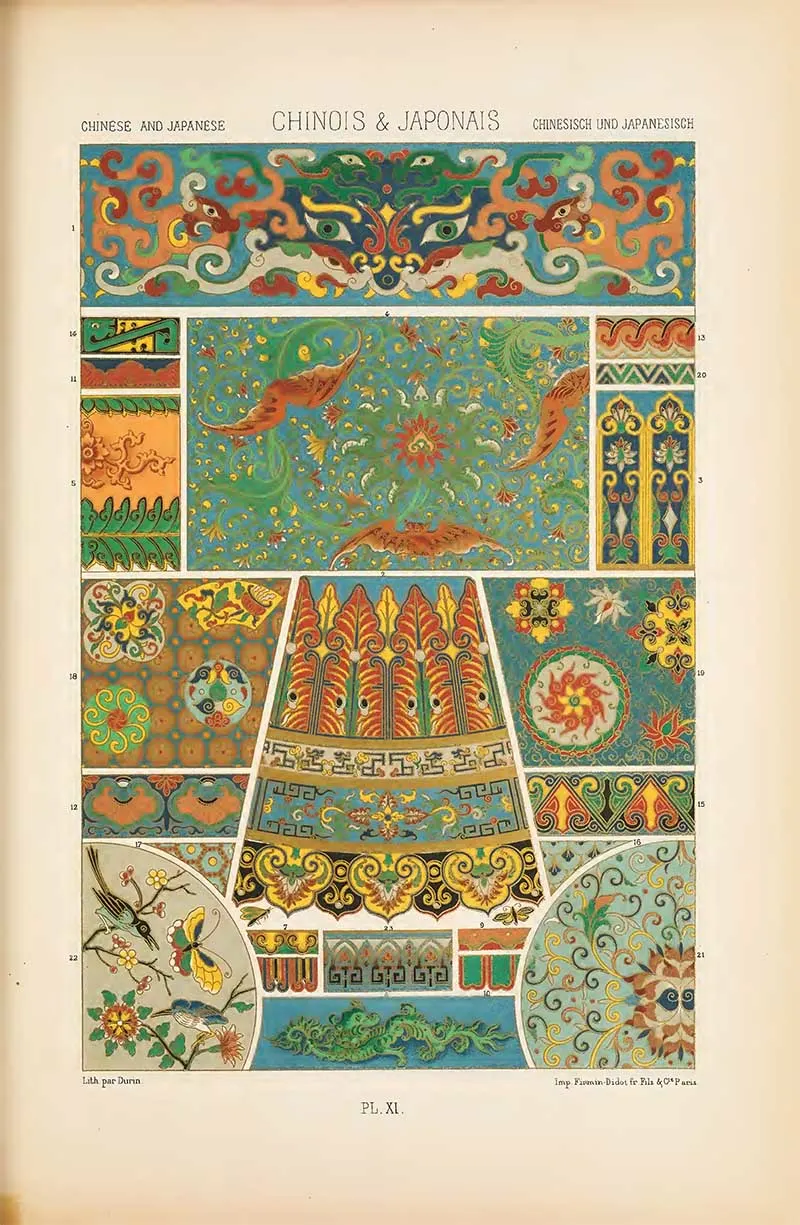
10. Indian Polychromatic Ornaments
Below are drawings of Indian embroideries, paintings, and Niellos. (Niello is a black mixture used as an inlay on engraved or etched metal, especially silver).
The floral art remind me of some of the Chintz vintage floral patterns.
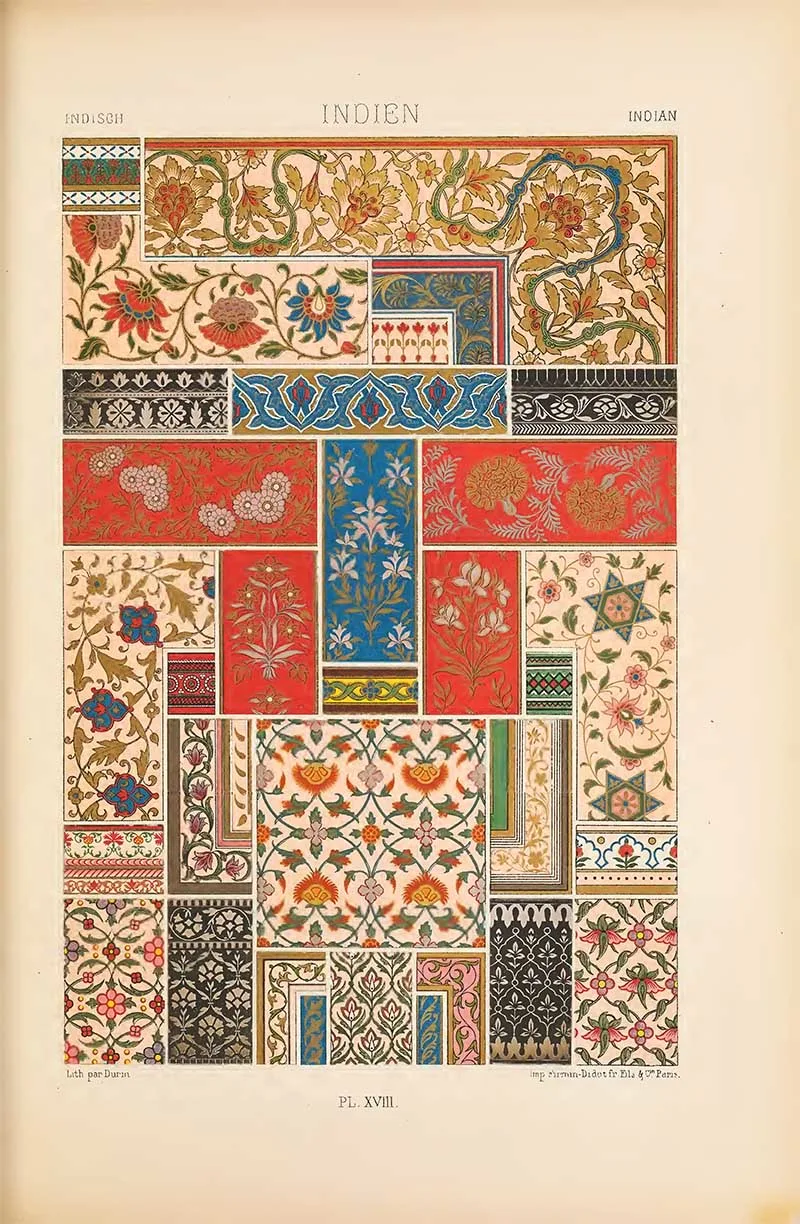
11. Persian Linen
Racinet’s drawings of Persian printed linen of flowers and animals.
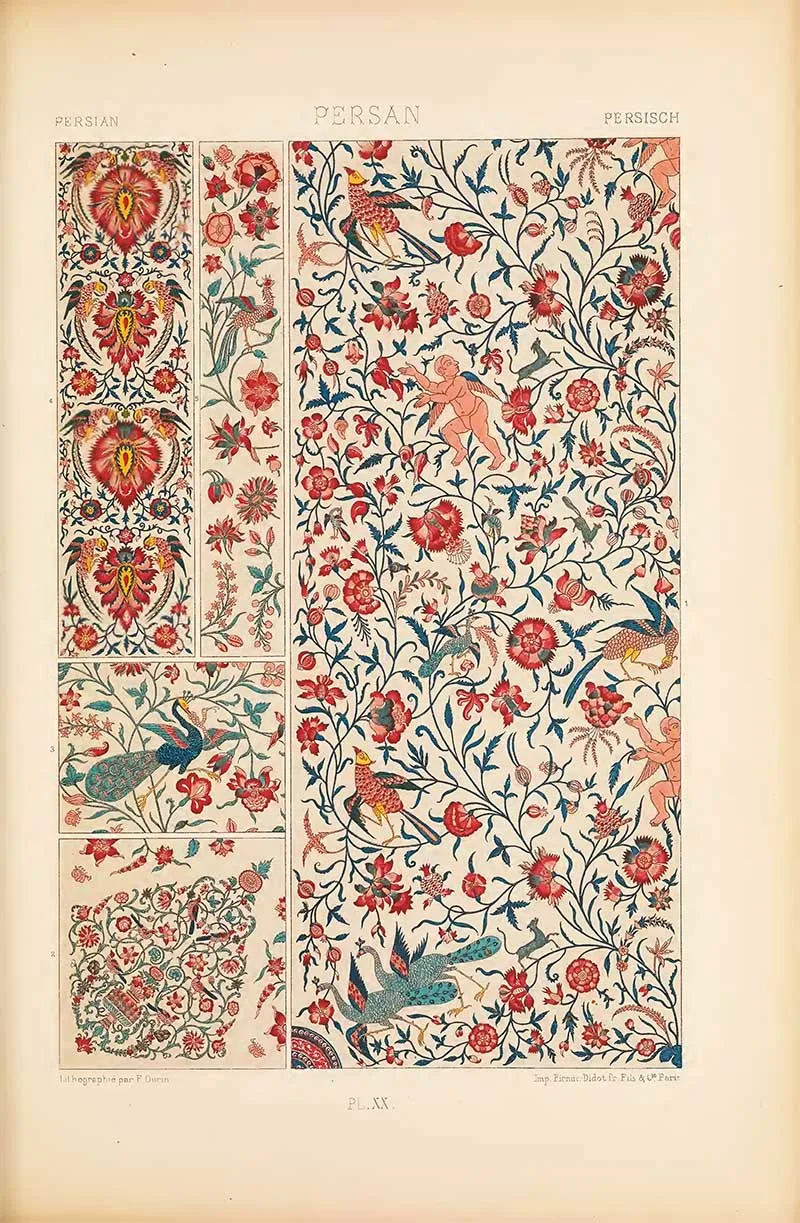
12. Persian Earthenware
Various examples in this plate give an accurate idea of the ornamentation system generally used in Persian earthenware.
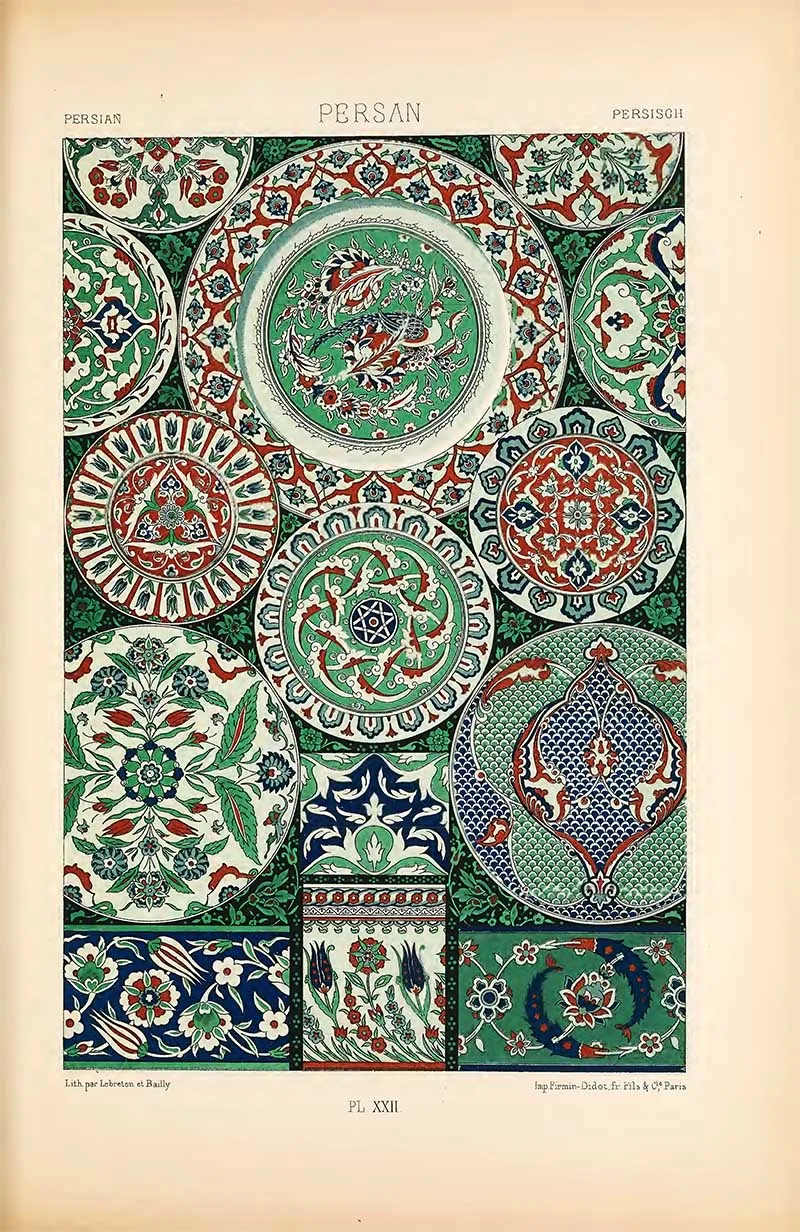
13. Moorish Art
All the specimens of mosaics and enamelled terra-cotta come from the Alhambra of Granada and the Alcazar of Seville.
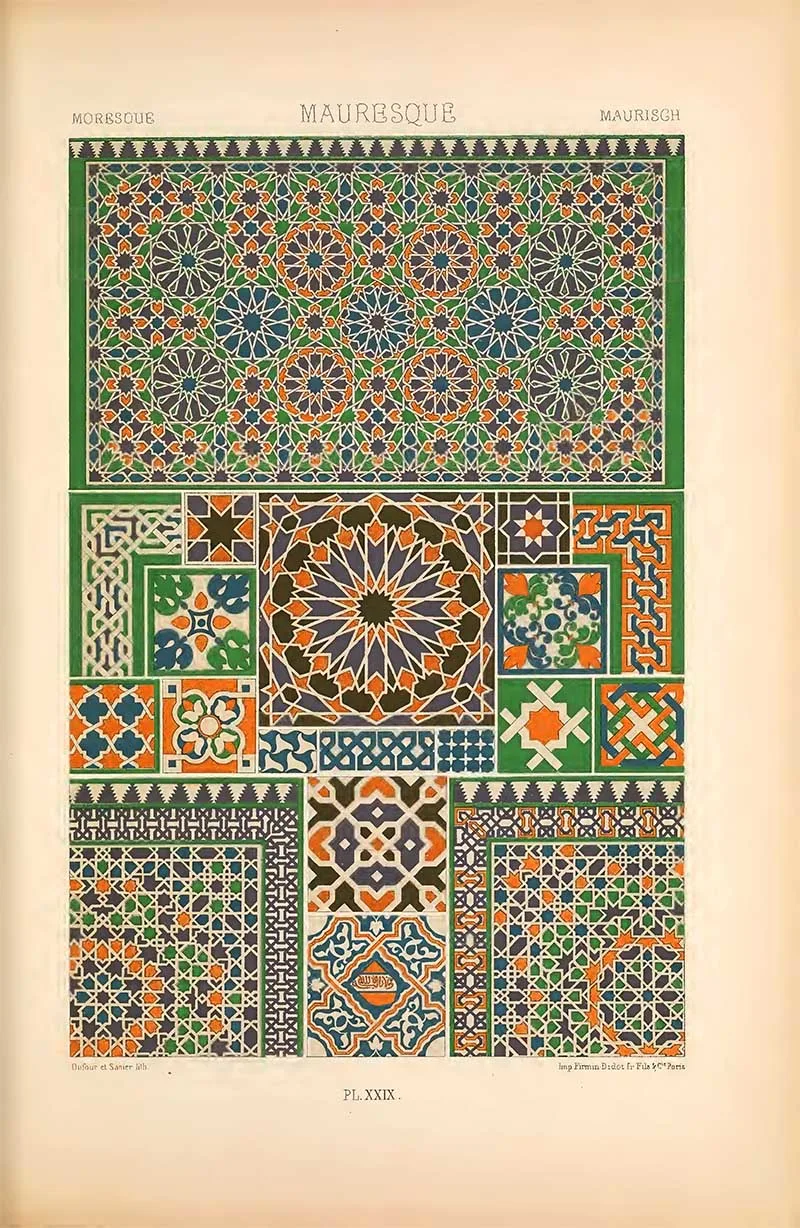
14. Middle Ages
Middle ages decorations on manuscripts.
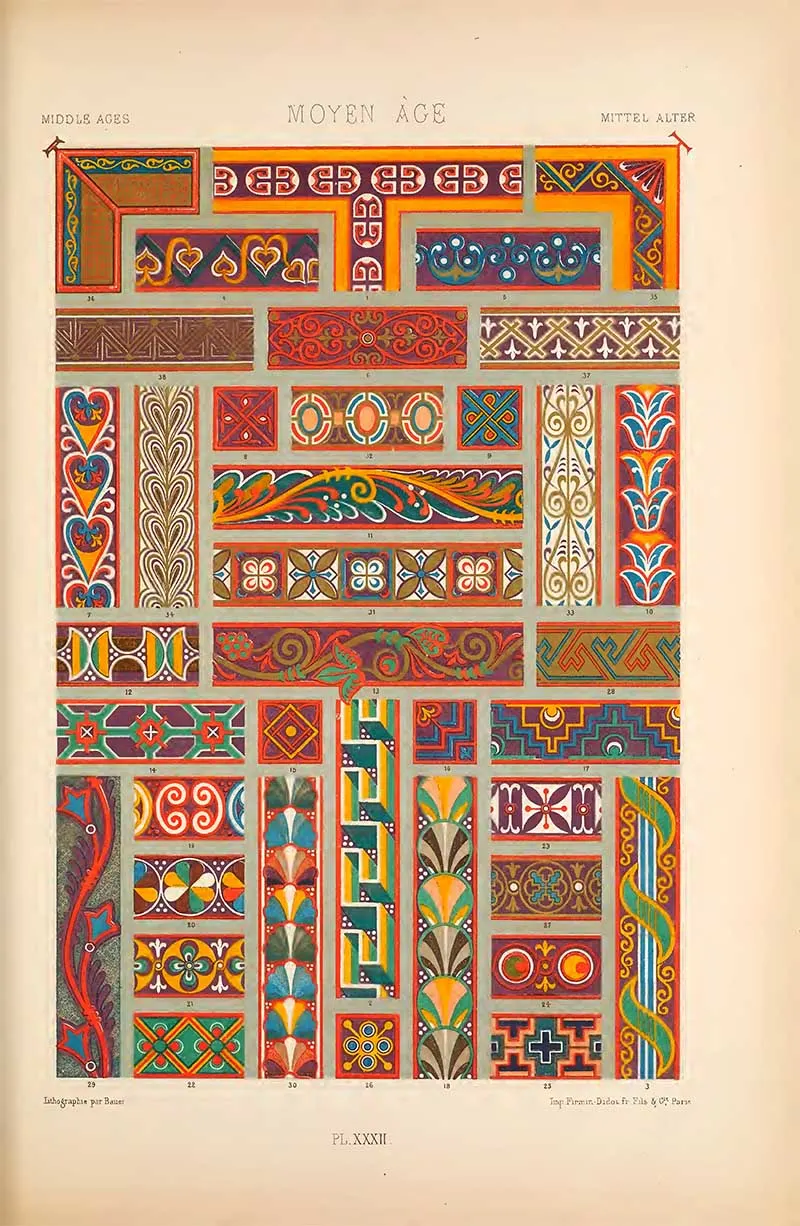
15. Middle Ages Windows
These window examples are from the 13th and 14th Centuries. Racinet wrote “Painting on glass attained its highest excellence in the thirteenth century. Simplicity and elevation of style were maintained during the fourteenth century, but in the fifteenth, these special characteristics were lost in excess of ornamentation.“
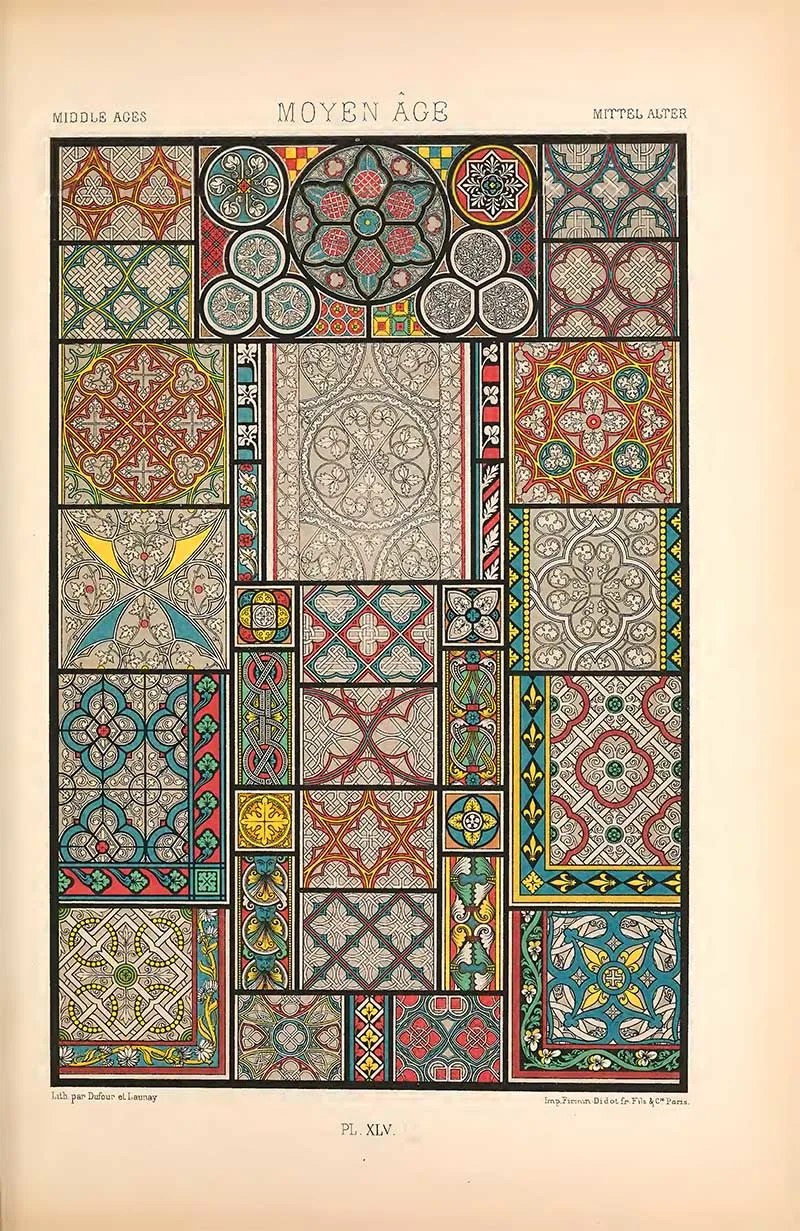
16. Celtic Ornaments
Celtic examples of polychromatic ornaments from the seventh, eighth, ninth, tenth and eleventh century.
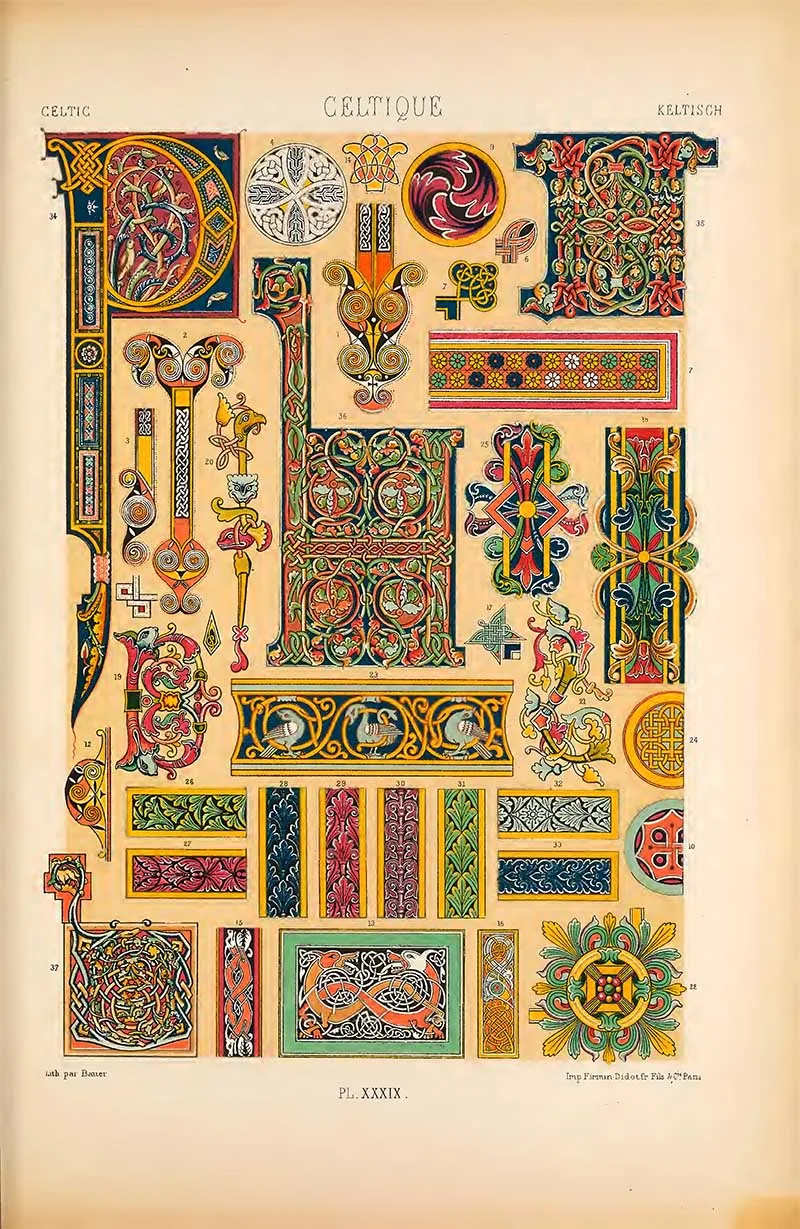
17. Renaissance L’Ornement Polychrome
Sixteenth century decorative grotesque paintings in the Vatican.
In art, grotesques are ornamental arrangements of arabesques with interlaced garlands and small and fantastic human and animal figures, usually set out in a symmetrical pattern around some form of architectural framework, though this may be very flimsy.
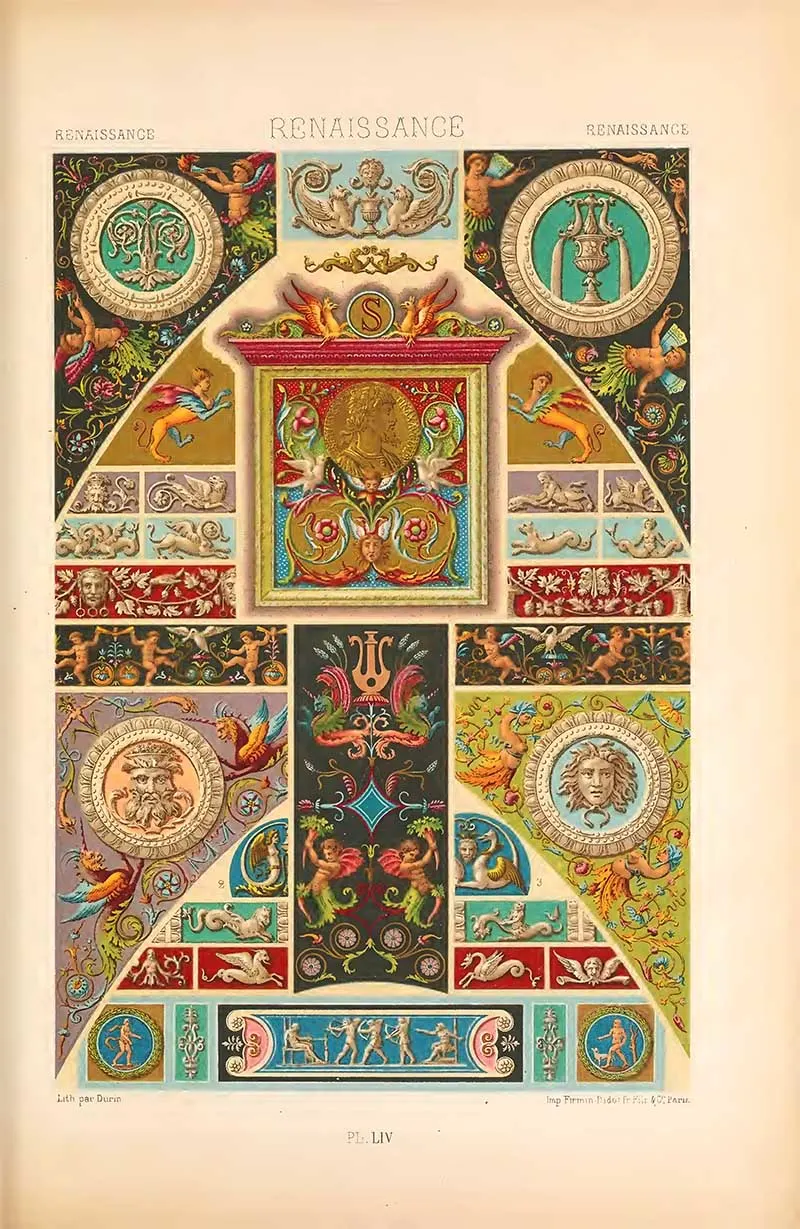
18. Renaissance Engraved Ivories
Engraved ivories come within the scope of polychromatic ornamentation because they combine white and black. Sometimes black forms the background of the general design, at others, it is used as a means of relieving and displaying the design.
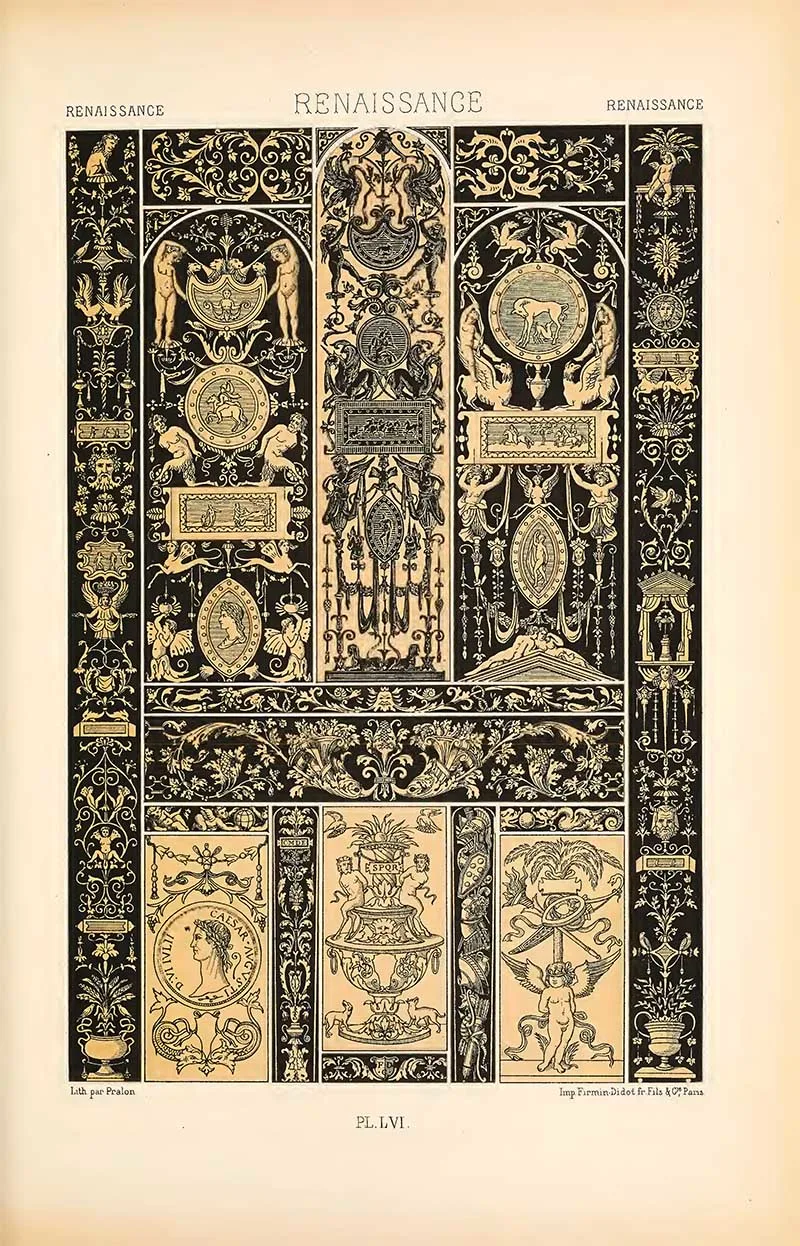
19. Renaissance Enamelled Earthenware
The dishes and borders contained in this plate are specimens of the workmanship of Bernard Palissy.
Bernard Palissy (1510 – 1589) was a French Huguenot potter, hydraulics engineer, and craftsman famous for having struggled to imitate Chinese porcelain for sixteen years.
He is also well known for his contributions to the natural sciences and is famous for discovering geology, hydrology, and fossil formation principles. Palissy was imprisoned for his belief during the tumultuous French Wars of Religion and sentenced to death. He died of poor treatment in the Bastille in 1589.
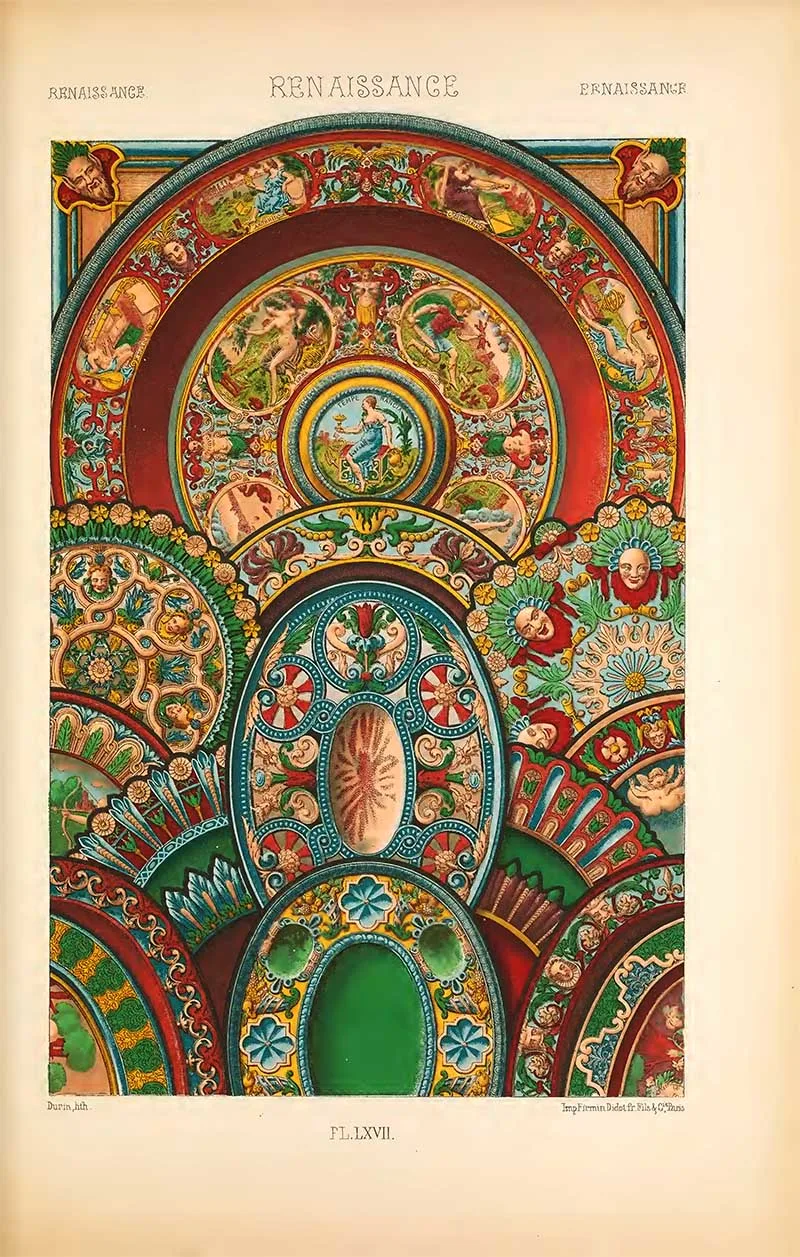
20. Sixteenth Century Cartouches L’Ornement Polychrome
A cartouche is an oval or oblong design with a slightly convex surface, typically edged with ornamental scrollwork.
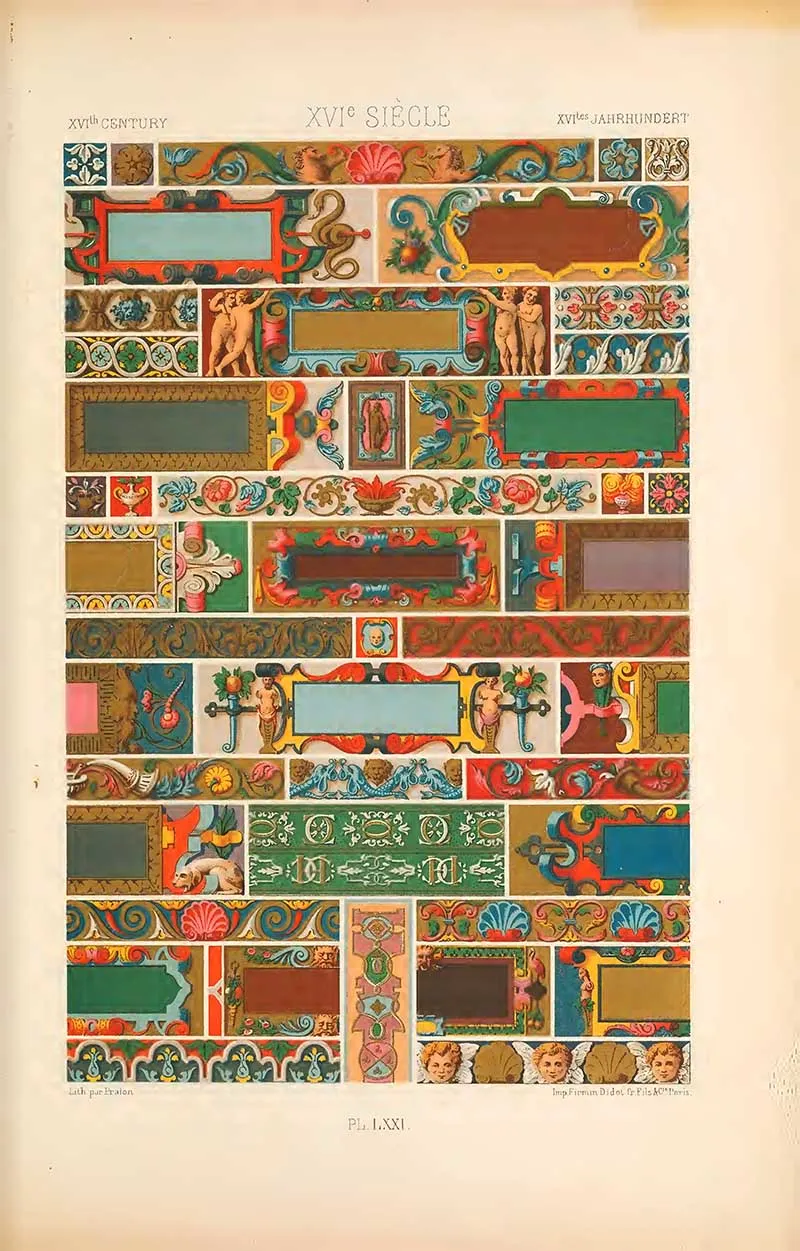
21. Seventeenth and Eighteenth Century Earthenware Patterns
For the book, Albert Racinet drew several decorative patterns selected from specimens of French earthenware from the Cluny Museum.
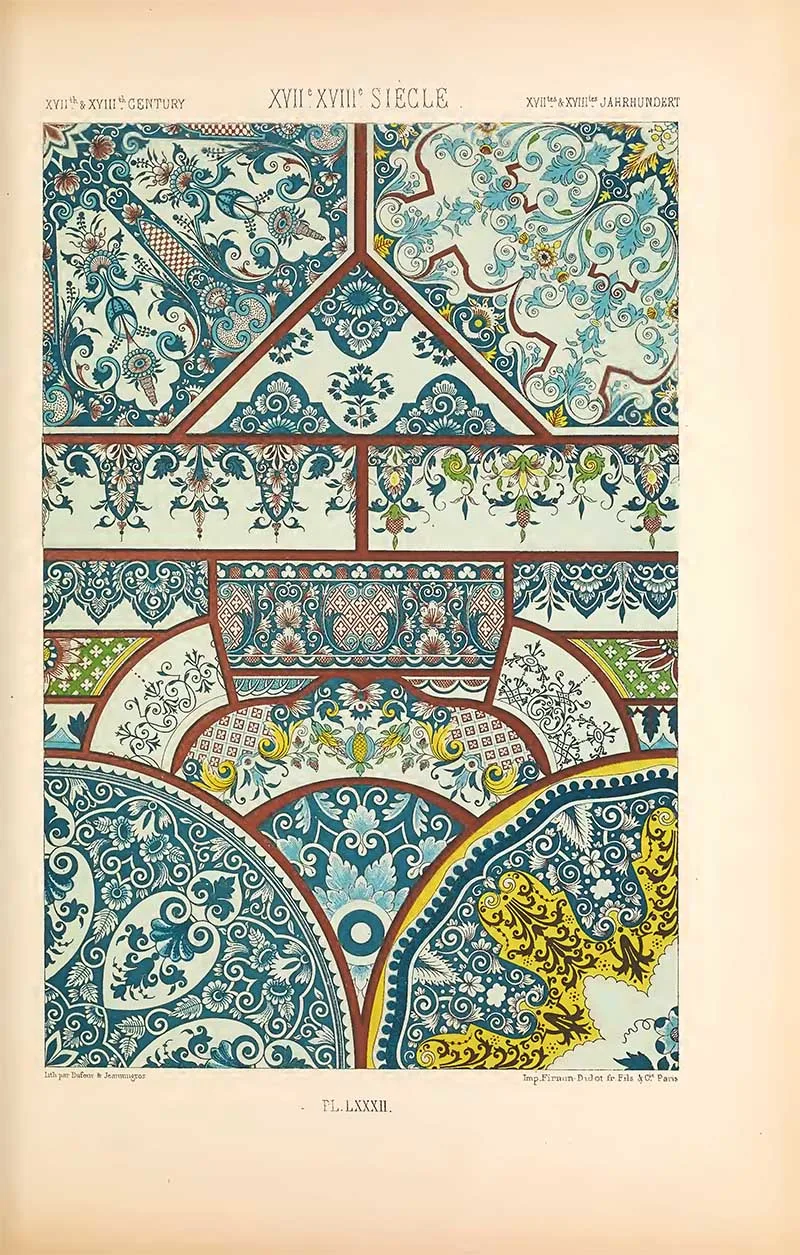
22. Albert Racinet Seventeenth Century Carpet.
A Louis IV style carpet pattern.
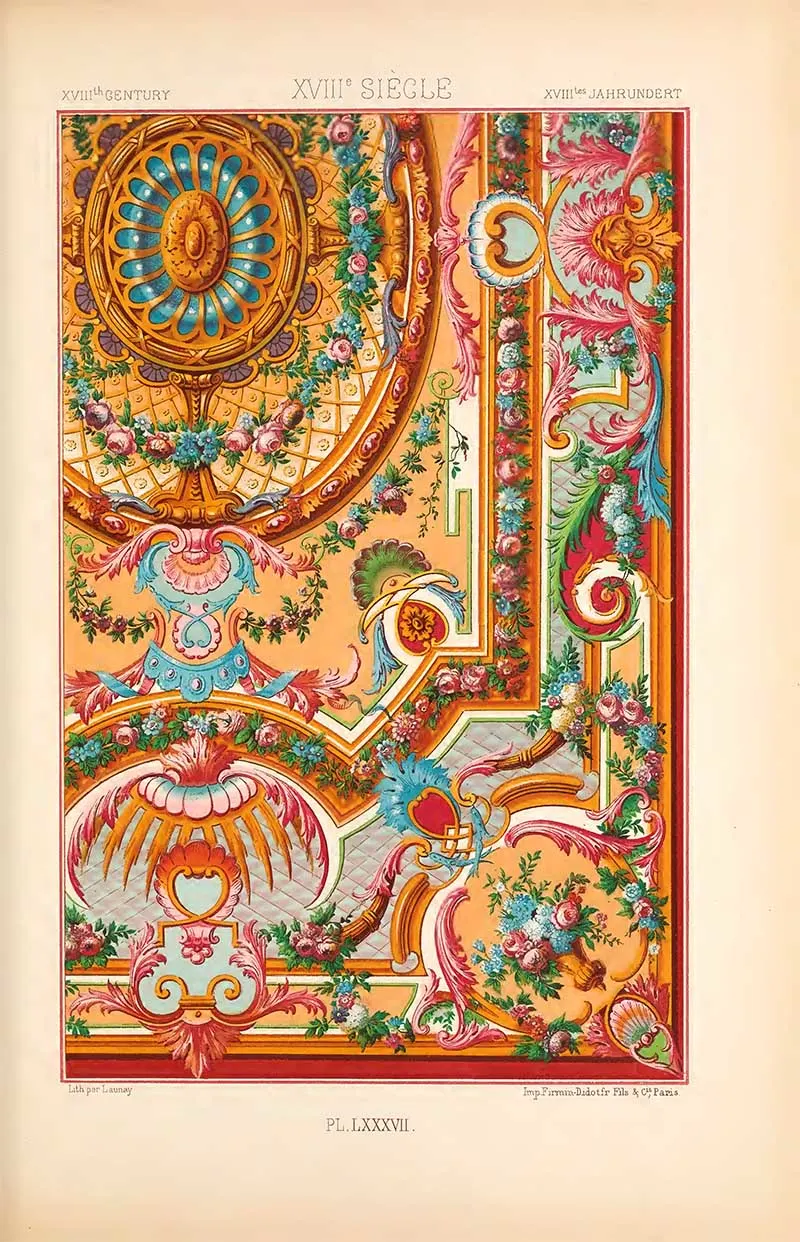
23. Eighteenth Century Cartouches
Another collection of cartouches from L’Ornement Polychrome.
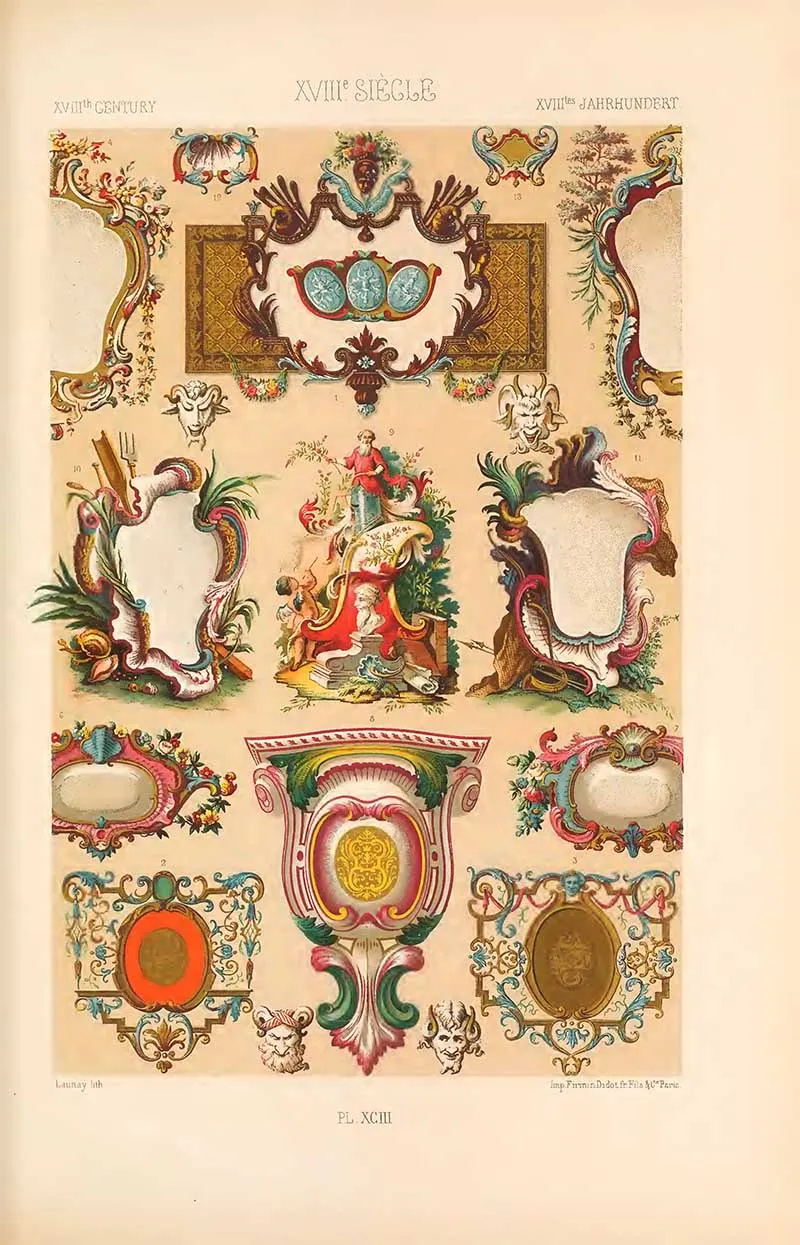
24. Eighteenth Century Patterns for Silks
Pattern designs for silk wall hangings and furnishings.
For more vintage wallpaper designs, check out the William Morris patterns on Pictureboxblue.
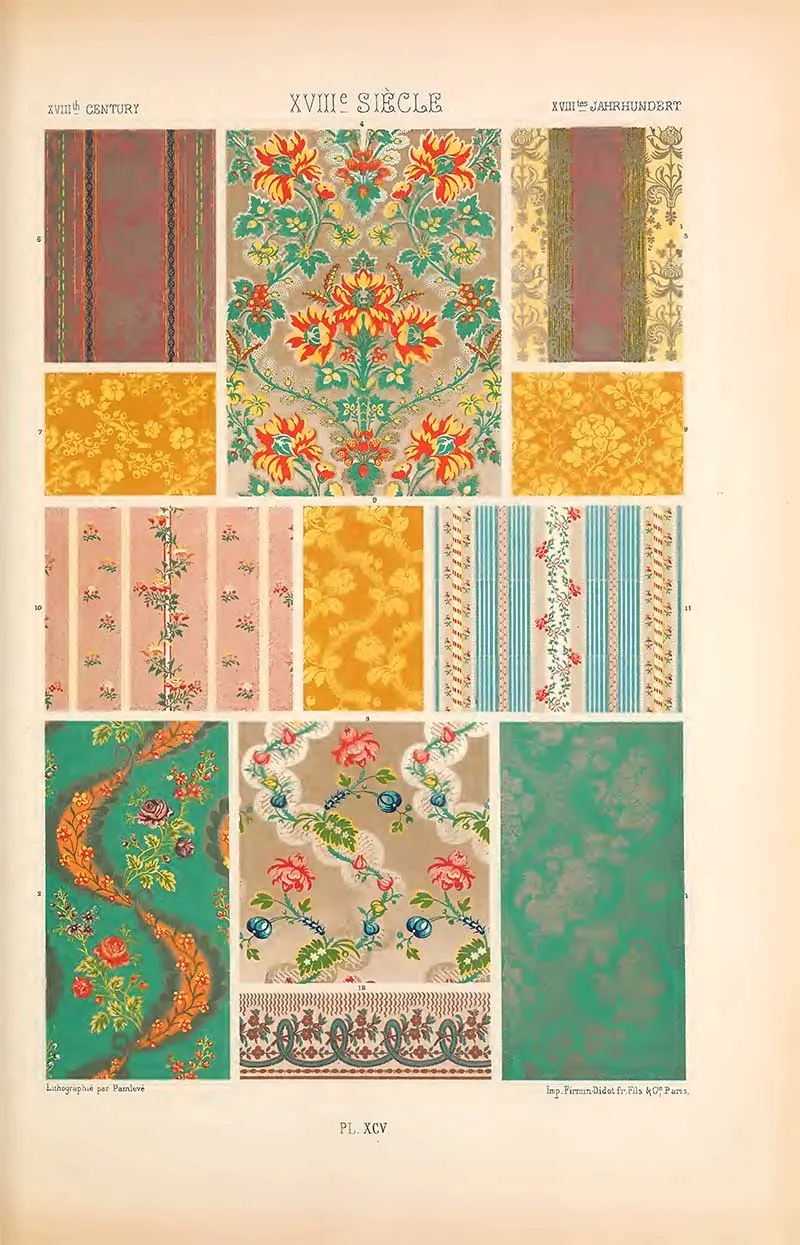
25. Patterns for Porcelain from Albert Racinet’s L’Ornement Polychrome
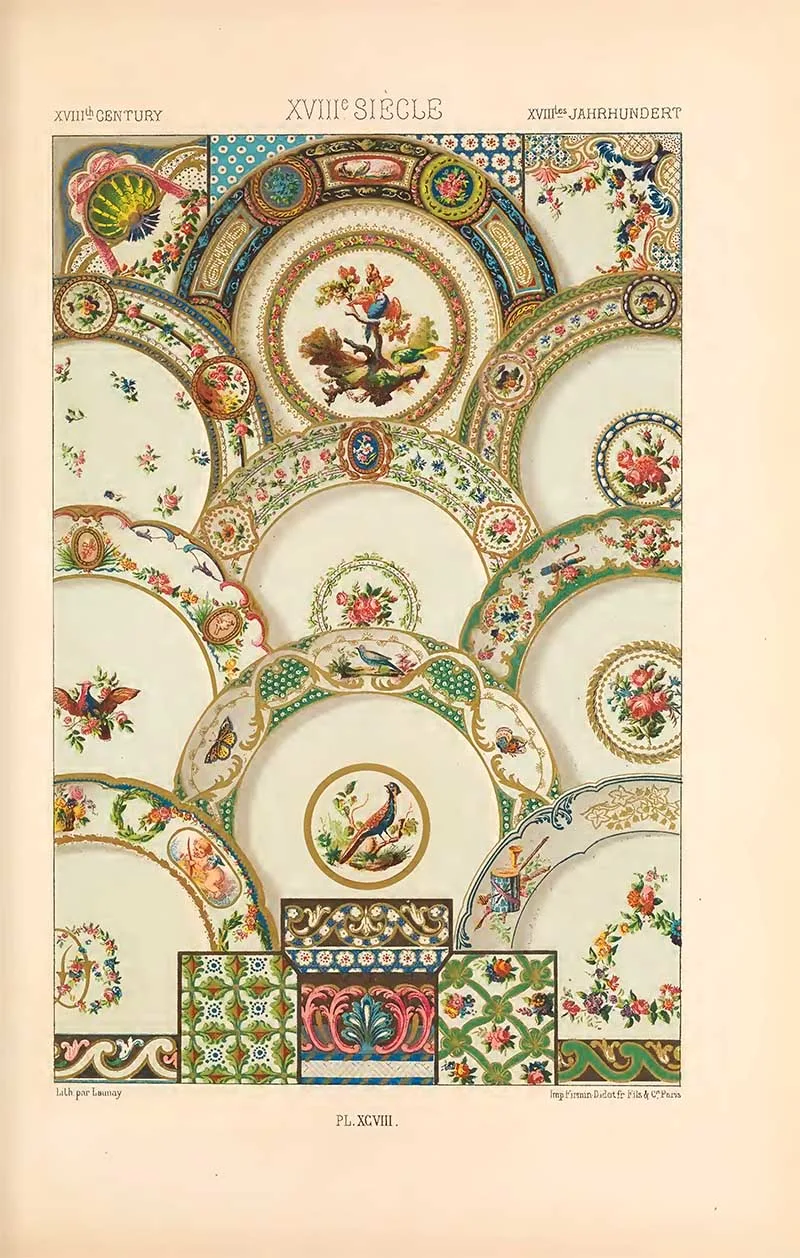
Another classic book focussed on ornamental design is Martin Gerlach’s “Die Pflanze in Kunst und Gewerbe“. Translates as The Plant in Arts and Craft 1886. The patterns in this book are all vintage plant art designs.
For American ornaments check out the Index of American Design.
Don’t forget to check out the other printable patterns, art and design collections on Pictureboxblue.com, such as those of Christopher Dresser and William Morris. Also, these prints are on colour and pattern designs and these Art Nouveau animal designs.

Renata
Friday 24th of November 2023
Celtic is my favorite too. Thank you for such amount of information and beauty.
claire
Monday 27th of November 2023
Thank you, I'm glad you enjoyed them.
Laura
Saturday 16th of October 2021
I learnt something from these this morning; I'd not seen all the colourful Celtic stuff before and it's now one of my favourites! Thank you!
claire
Saturday 16th of October 2021
Thank you, they are lovely prints.
Donna @ Modern on Monticello
Thursday 6th of May 2021
Such a beautiful book. Thanks for sharing the history and story of it. #HomeMattersParty
claire
Friday 7th of May 2021
Thank you so much, I just love all the patterns and designs.
Cecilia
Sunday 2nd of May 2021
What pretty patterns! Thanks for sharing at Vintage Charm!
claire
Monday 3rd of May 2021
Thank you so much, glad you enjoyed them.
handmade by amalia
Thursday 29th of April 2021
I came over from the Vintage Charm party to admire your patterns. Gorgeous. Amalia xo
claire
Friday 30th of April 2021
Thank you, they are lovely and good colors too.